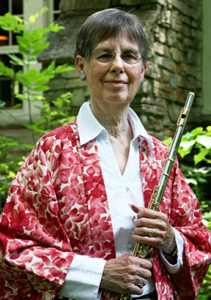 When the character Tamino in ”The Magic Flute” raises the title instrument to his lips, it is Jean Berkenstock who plays the lilting theme from the orchestra pit.
When the character Tamino in ”The Magic Flute” raises the title instrument to his lips, it is Jean Berkenstock who plays the lilting theme from the orchestra pit.
She is one of the usually unsung heroes of the Lyric Opera of Chicago, the principal flutist of the 76-person orchestra.
As essential as the orchestra is to any opera’s success, it is inevitably eclipsed as soon as the overture is over; still, this has been a banner season for Berkenstock.
She has prominent parts in two current productions-Mozart’s ”The Magic Flute” and Bizet’s ”Carmen”—and also was featured in Donizetti’s ”Lucia di Lammermoor” last fall.
”These three are all such great pieces, and they’re so different; the flute has really wonderful parts in them,” Berkenstock says. She has performed ”Carmen” and ”Lucia” four times each and ”Flute” three times since joining the Lyric Opera orchestra in 1969.
A graduate of Illinois Wesleyan College, Berkenstock played with the Atlanta Symphony before eventually returning to Chicago.
The famous mad scene in the third act of ”Lucia” presented the greatest challenge for Berkenstock this season: staying with soprano June Anderson as she roamed the stage and railed against being forced to marry someone she doesn’t love.
”The flute introduces the theme of the mad scene; it’s really very beautiful music,” Berkenstock says. ”Lucia sings, and the flute plays passages with her in harmony and alone. Gradually there’s more and more flute, and the flute is getting more and more impassioned as the scene progresses.
”At the cadenza, which is just flute and soprano, the flute answers the soprano several times. It’s very free and wild, in terms of tempo. Some sopranos do it pretty much the same each time, and some are very variable.”
Anderson was the latter. To synchronize with the soprano, Berkenstock moved from the orchestra pit to the conductor’s platform. ”The staging was wonderful, with a large castle that could fall down on itself to form a ledge,” Berkenstock recalls. ”June stood on it, lay on it, climbed down, would run to the statue and tear her hair-she was extremely dramatic. . . . I had to watch her every instant.”
It was the second time Anderson and Berkenstock did ”Lucia” together.
”Having worked with Jean in 1986, I was confident,” said Anderson in a phone interview from New York. ”I’m always active, but this time in Chicago I was even more so; it’s very hard for Jean, but she’s wonderful. She’s with me all the way. It didn’t take very long for her to get what I was doing.”
”Basically, people go (to ‘Lucia’) to hear the cadenza; it’s the most famous part of the opera. It’s only a minute; it’s very intense, just me and the flute. It’s very important that (we) think together, so it comes out.”
”Jean’s intuitive sense with June Anderson was just uncanny,” says Lyric cellist Laura Deming. ”All the pressure she was under just seemed to help focus her on being one with the soprano. Her sound is rich, really thick and smooth. It’s quite unique, not like air passing through metal.”
In the production of ”Carmen,” which ends Saturday, Berkenstock’s interpretive opportunities run the gamut. ”The opera tests everything: color, low register, dynamics, and articulation,” she notes. Her playing is in turn impish and plaintive, seductive and sweet, forceful and flippant.
Her duet with harpist Liz Cifani before the curtain rises on the third act is the lyrical calm before the stormy breakup of the gypsy Carmen and Don Jose. During that musical interlude, Cifani says: ”I don’t even have to look at the conductor. All I have to do is listen to Jean. I’ve always loved the way she plays.”
When the ”Flute” production and the Lyric season end in early February, Berkenstock and her husband, Jim, the Lyric’s principal bassoonist, will play during the American Ballet Theatre run. They will also perform with Symphony II at Pick-Staiger Hall in Evanston, with the Grant Park Symphony downtown, and in their own summer chamber concert series in Door County, Wisconsin.
”It’s a nice balance; what we do symphonically benefits our opera playing, and what we do in the opera makes our symphonic playing more expressive,” Berkenstock says. ”I just love to play the flute. I always have. I’m lucky to be one of those people who always knew what I wanted to do, and have the opportunity to do it.”
By Magda Krance
Chicago Tribune
Published January 25, 1991
